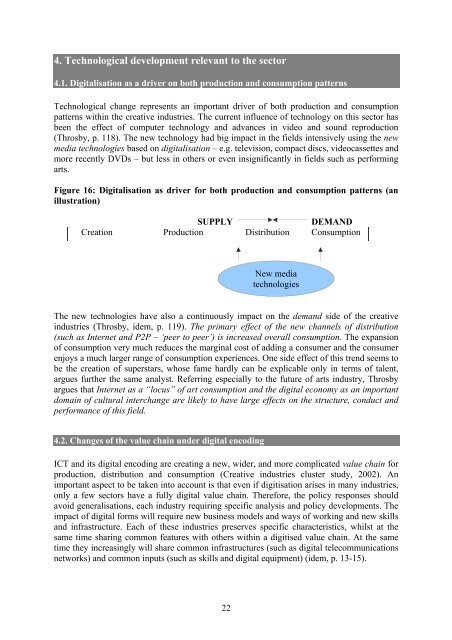Future of Creative Industries - Implications for Research ... - Europa
Future of Creative Industries - Implications for Research ... - Europa
Future of Creative Industries - Implications for Research ... - Europa
You also want an ePaper? Increase the reach of your titles
YUMPU automatically turns print PDFs into web optimized ePapers that Google loves.
4. Technological development relevant to the sector4.1. Digitalisation as a driver on both production and consumption patternsTechnological change represents an important driver <strong>of</strong> both production and consumptionpatterns within the creative industries. The current influence <strong>of</strong> technology on this sector hasbeen the effect <strong>of</strong> computer technology and advances in video and sound reproduction(Throsby, p. 118). The new technology had big impact in the fields intensively using the newmedia technologies based on digitalisation – e.g. television, compact discs, videocassettes andmore recently DVDs – but less in others or even insignificantly in fields such as per<strong>for</strong>mingarts.Figure 16: Digitalisation as driver <strong>for</strong> both production and consumption patterns (anillustration)SUPPLYDEMANDCreation Production Distribution ConsumptionNew mediatechnologiesThe new technologies have also a continuously impact on the demand side <strong>of</strong> the creativeindustries (Throsby, idem, p. 119). The primary effect <strong>of</strong> the new channels <strong>of</strong> distribution(such as Internet and P2P – ‘peer to peer’) is increased overall consumption. The expansion<strong>of</strong> consumption very much reduces the marginal cost <strong>of</strong> adding a consumer and the consumerenjoys a much larger range <strong>of</strong> consumption experiences. One side effect <strong>of</strong> this trend seems tobe the creation <strong>of</strong> superstars, whose fame hardly can be explicable only in terms <strong>of</strong> talent,argues further the same analyst. Referring especially to the future <strong>of</strong> arts industry, Throsbyargues that Internet as a “locus” <strong>of</strong> art consumption and the digital economy as an importantdomain <strong>of</strong> cultural interchange are likely to have large effects on the structure, conduct andper<strong>for</strong>mance <strong>of</strong> this field.4.2. Changes <strong>of</strong> the value chain under digital encodingICT and its digital encoding are creating a new, wider, and more complicated value chain <strong>for</strong>production, distribution and consumption (<strong>Creative</strong> industries cluster study, 2002). Animportant aspect to be taken into account is that even if digitisation arises in many industries,only a few sectors have a fully digital value chain. There<strong>for</strong>e, the policy responses shouldavoid generalisations, each industry requiring specific analysis and policy developments. Theimpact <strong>of</strong> digital <strong>for</strong>ms will require new business models and ways <strong>of</strong> working and new skillsand infrastructure. Each <strong>of</strong> these industries preserves specific characteristics, whilst at thesame time sharing common features with others within a digitised value chain. At the sametime they increasingly will share common infrastructures (such as digital telecommunicationsnetworks) and common inputs (such as skills and digital equipment) (idem, p. 13-15).22














